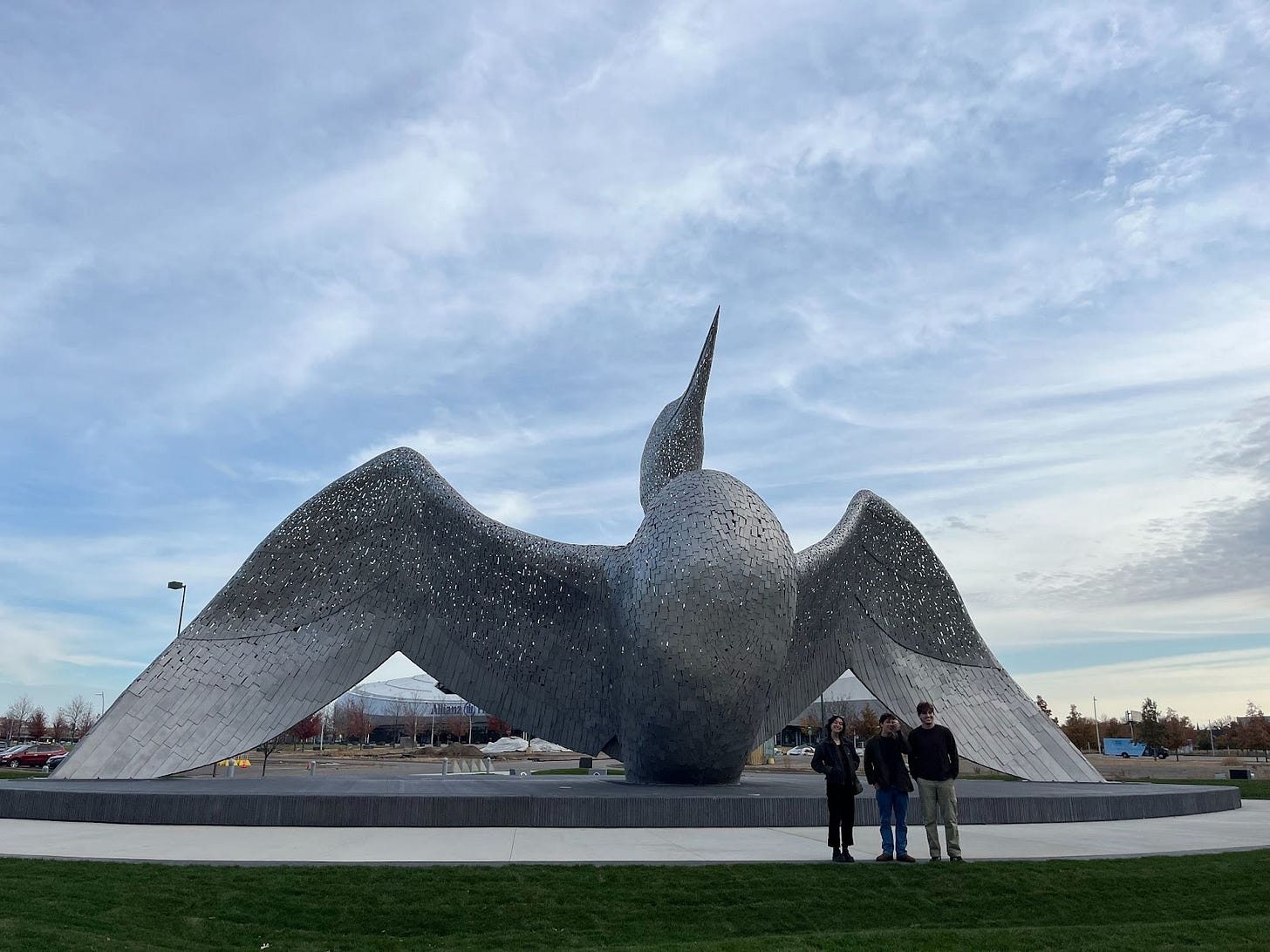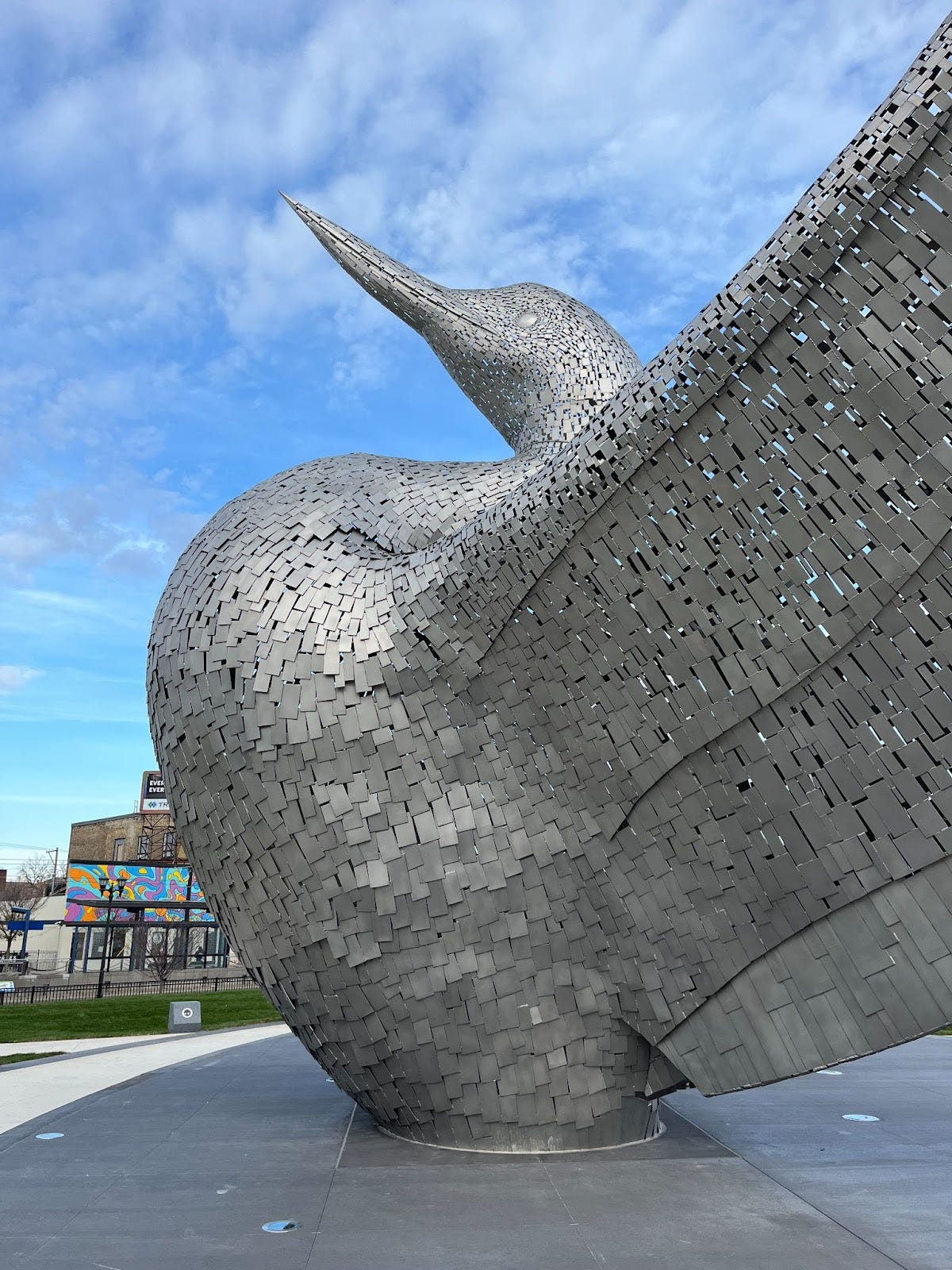A few weeks ago, I had an article published in Racket, the Twin Cities’ digital alt-weekly of sorts, comparing Chicago’s very famous Bean sculpture to Saint Paul’s brand new (and not-so-famous) Loon sculpture.
The article offered an opportunity to reflect on longer-term revitalization in cities. Lately, Saint Paul has been in an economic tough spot. For a variety of reasons, housing development has fallen steeply in the city, leaving major development projects stalled. At the same time, commercial real estate has been whalloped since the pandemic, with remote work emptying out an already-quiet downtown. In addition to localized challenges in areas like downtown, this bodes poorly for Saint Paul at large. As the commercial tax base has shrunk, residential property taxes have been rising, and the city recently raised its sales tax to the highest rate in Minnesota.
The Hamline-Midway neighborhood, where the Loon sculpture was built, offers one case study of Saint Paul’s current struggles. Currently, the Loon sculpture is surrounded by a sea of parking lots, facing a long-empty CVS building standing opposite on the intersection. Plans for major redevelopment in this area, led by the opening of soccer stadium Allianz Field in 2019, have been stalled for years.
In the Racket piece, I tried to offer a reminder of how meaningfully urban places can revitalize under the right conditions. After all, the Bean — one of Chicago’s most iconic sights — sits in a park that was just a bunch of empty train tracks little more than two decades ago. The degree of Millennium Park’s success would have felt unimaginable in the early 1990s.
I think this gives hope for a place like Saint Paul. Even if prospects for a more prosperous and vibrant city can appear dim in the short-term, we should keep in mind how much local fortunes can change over time. I’m optimistic that the Loon sculpture can be a first step in that direction.
I hope you read the original article in Racket. In this blog post, I want to widen my lens to think about some of the economics of urban growth and decline, and reflect on what this might mean for the future of Saint Paul.
Fundamentally, urban ecosystems are driven by all kinds of feedback loops, both negative and positive.
Many cities have emerged positively from moments of struggle like St. Paul is dealing with. That’s the parallel I tried to draw between Chicago’s Bean and Saint Paul’s Loon: most tourists taking selfies at the Bean today would have a hard time believing that Millenium Park was just a bunch of train tracks little more than two decades ago.
In the longer term, such positive feedback loops are possible, both at a very local scale and across a city.
Localized cycles of vitality (or lack thereof)
In urban economic history, researchers have documented instances where sudden destruction to a city opened up new development, sparking a virtuous cycle of local growth and vitality. For example, Boston’s Great Fire of 1872 damaged large portions of the city’s downtown, but in the aftermath, new buildings came back quickly and of higher quality than before. However, improvement didn’t only occur in the direct path of destruction — if a building was undamaged but close to the fire’s path, it was actually more likely to be upgraded than other undamaged buildings. Redevelopment of burnt-down buildings generated positive benefits for their neighbors.
Similarly, it’s possible to imagine new construction in downtown Saint Paul or Hamline-Midway creating positive externalities for its neighbors. A few successful developments could serve as a tipping point to support investment in the whole neighborhood.
These spillovers won’t always happen, however. For example, other economists have examined the impacts of 1968 civil disturbances in Washington, D.C., which occurred in response to Martin Luther King Jr.’s assassination. During the resulting unrest, some buildings on neighborhood retail corridors were burned down in the ensuing protests and unrest. Instead of sparking a virtuous cycle of rebuilding, however, these lots were still more likely to be vacant 30 or 40 years later.
Why didn’t these commercial strips of D.C. see a virtuous cycle of redevelopment after the civil disturbances? Larger-scale economic conditions determine whether positive local cycles can begin in the first place. Like many American cities, from the 1960s through the 1990s D.C. was bleeding population to the suburbs. Many neighborhoods, particularly poorer, segregated black neighborhoods, faced major disinvestment from private capital. These pressing economic conditions explain why newly vacant lots could remain undeveloped for many years. 1970s-era D.C. was very different from 1870s-era Boston, in which the population was doubling every two or three decades.
In other words, redevelopment opportunities can spark virtuous cycles of local improvement — when the economic context is right. In the wrong context, urban areas can lay fallow for decades.
Citywide economic challenges
Watching how much development has slowed in Saint Paul, it’s easy to fear that Saint Paul is currently in the wrong economic context. The reasons for this are multiple, including post-COVID migration to the suburbs, downtown’s remote work challenges, absentee property management, and relatively modest regional economic growth in recent years. The city’s rent control policy — especially initially, when it was among the most stringent in the nation — has also had substantial tradeoffs. Not every reason for slow growth is negative; as I recently argued, the Twin Cities’ slow housing development also has to do with low rent growth, which is in many ways a positive outcome. But while low rent growth is good, stagnation is certainly not what Saint Paul should want.
In the next few years, Saint Paul is staring down the post-COVID “urban doom loop.” Don’t mistake the urban doom loop for some of the most extreme claims that the pandemic would spell the “death of cities.” Rather, the urban doom loop, as theorized by a handful of economists in the past few years, focuses on cities facing tax base woes brought on by remote work. As the value of office real estate collapses, cities must make a choice: they can either shift taxes to residential property, tax residents in other ways, or cut back on services. None of these options are particularly attractive, and Saint Paul will likely end up doing a little bit of all three.
In a 2023 Atlantic article, housing policy researcher Alex Armlovich wrote that “people are worrying about the wrong downtowns.” Big-city downtowns like San Francisco and New York have received the bulk of attention about post-COVID downtown office vacancies. But even before 2020, mid-size, steady-population cities — just like Saint Paul — already had low office prices and challenges with unused office space. In the face of remote work, the post-COVID urban doom loop is most salient, with buildings facing demolition or abandonment.
In the case of Saint Paul, this prediction has become prescient indeed. Downtown offices have struggled mightily, property taxes have gone up, sales taxes were increased in 2024, and tight budgets fights have put city services at risk.
Over time, financial constraints continue to grow as when cities struggle. As Destin Jenkins documents in The Bonds of Inequality, as San Francisco’s population started to suburbanize and the city faced racial unrest of its own in the late 1960s, the city’s access to bond markets declined. This greatly constrained possibilities for public investment, particularly in poorer and nonwhite areas that were not deemed “sound” public investments. Combined with rising interest rates in the 1970s, the structural constraints of municipal debt further forced the San Franciscans’ hands, necessitating difficult sacrifices to the city budget. This is yet another negative feedback loop that I worry about for Saint Paul.
Many American cities have also recovered from even these most dramatic downturns. The beginning of the 21st century represented a marked shift as younger, whiter, and more educated Americans started moving back to core-city neighborhoods — reversing a longstanding trend of this group primarily moving to the suburbs.
Inevitably, large-scale growth like this comes with major challenges of its own as neighborhoods face gentrification. Incumbent residents often become increasingly unable to shape the future of their neighborhoods. Their housing costs grow, but longtime residents may not always particularly value new retail amenities that target other demographics. Inevitably, some residents lose out as they’re forced to leave. If the neighborhood surrounding Saint Paul’s Loon sculpture can eventually spark a positive cycle of change, this neighborhood will surely grapple with those challenges (indeed, it already has within recent memory).
For now, however, most of Saint Paul seems a long way away from this type of cataclysmic local change, where the problem is too much demand to live in a neighborhood. For the most part, their problems are the opposite. This is true at both local levels in areas like the Midway, and at the scale of Saint Paul’s entire urban system, as citywide population growth is projected to be quite modest.
I love Saint Paul very dearly, and I still maintain optimism about the city’s future — it is certainly not doomed. There are positive stories about the city’s economic future. Recently, I covered some of the new housing developments taking advantage of Saint Paul’s recent top-notch zoning reforms. As another example, the city continues to benefit from the buildout of the Twin Cities’ rapid bus network, improving public transit for residents.
Yet thinking about both historical and contemporary research on the feedback loops that drive urban revitalization and decline is important, even if some of the lessons are pessimistic. I hope it can help St. Paulites consider the stakes of the city’s current moment, and the future challenges and opportunities that await.






Thanks for this insightful piece. Your discussion of Snelling/University reminds me of the Mill District in Minneapolis in the 1980s: acres of parking lots surrounding crumbling buildings. The revival began with the Whitney Hotel project siting all by itself in the late 1980s and then slowly growing into the area we see today. It took time and lots of false starts.
Thanks for this. We moved to the West 7th neighborhood near downtown last year, and while I love Saint Paul I hadn’t quite realized how much the hollowing out of downtown might be a problem. Nice to get a dose of some optimism!